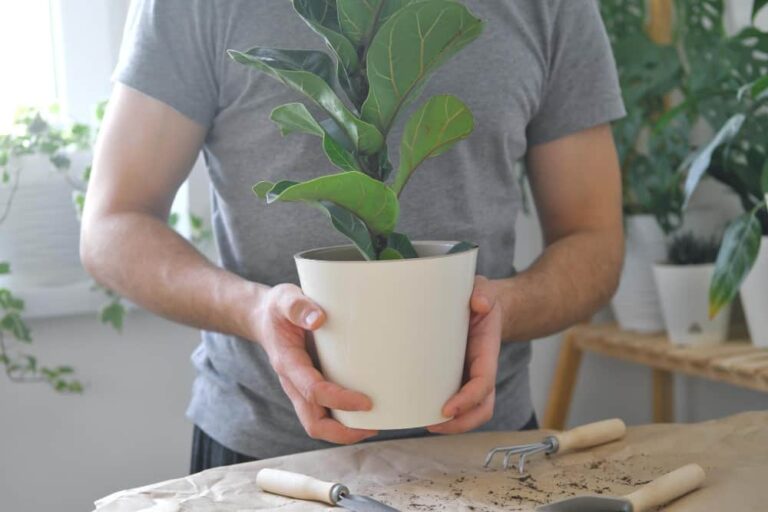How to revive a fiddle leaf fig: The ultimate guide
If you’re looking for a houseplant that is both easy to care for and handsomely rewarding, Fiddle-leaf figs may be a perfect choice. But due to a busy routine, you probably don’t have much time to give your fiddle leaf plant the attention it deserves.
But don’t worry. You can attempt some easy methods to help your fiddle get back to health. Even if you only have a few minutes every week, it’ll make a big difference over time. In this post, we outline some of the most common tips for helping how to revive a fiddle leaf fig.
How can you revive a fiddle leaf fig?
Before we learn how to revive a fiddle leaf fig, we first need to understand the common reason for fiddle leaf fig drying. A few culprits can ruin your fig tree and the leaves.
Overwatering:-
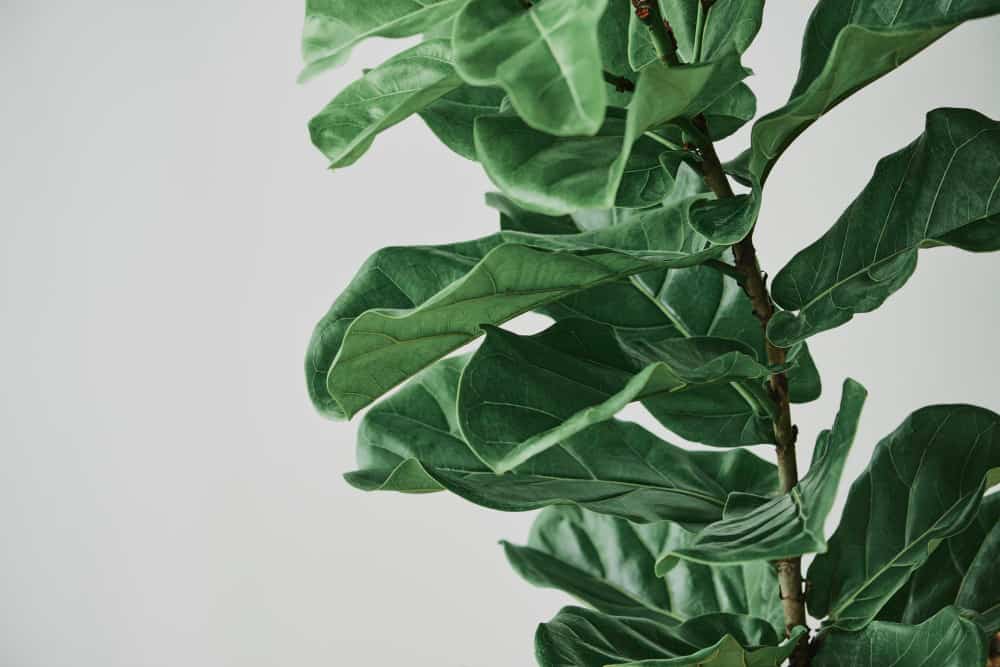
If you notice that your fig leaves are yellow and falling off, it is probably time to water them less frequently. Overwatering can be disastrous for fiddle leaf figs.
Water accumulates on the leaves of these trees due to continuous watering or flooding. When this happens, the plant’s tissues start rotting inside and out as moisture seeps into the plant roots and attacks their cells.
This process often takes months or even years to fully unfold, so if you notice that your fig leaves are starting to turn yellow and fall off gradually. When excess water accumulates on the leaves, causing them to rot.
Fiddle leaf figs are especially susceptible to this problem because their roots grow deep in the soil, so watering them too frequently can cause waterlogging and eventual root rot. DON’T WATER THEM! Give them plenty of time to adjust without constantly having access to fresh water.
There are a few simple steps you can take to prevent fig leaves from turning yellow and falling off:
- Check the plants regularly for signs of water stress. If the leaves or stems look wilted, droopy, or brown, it’s time to water them less frequently.
- Allow their roots enough space to breathe and spread nutrients around naturally. Keep soil moist but not soggy. Avoid watering in direct sunlight because this will cause the plant to dry out even more rapidly.
- Mulch around the base of your fiddle leaf fig tree if extra moisture keeps soils wetter than they should be. This will help retain moisture and reduce potential root rot risks.
- Check the drainage holes to ensure excess water doesn’t gather in the soil. Watering can cause root problems and salinity buildup, killing your popular houseplants.
- Ensure the soil is aerated, absorbing water quickly and preventing it from staying in the soil for days. This helps reduce moisture stress on plants.
- Provide sufficient light so that roots can access moisture even during dry periods. Artificial lighting should only be used if sunlight isn’t available naturally due to shading or weather conditions.
- Prune brown leaves and damaged parts to help improve airflow and promote better growth; this will also reduce potential water shortages during droughts.
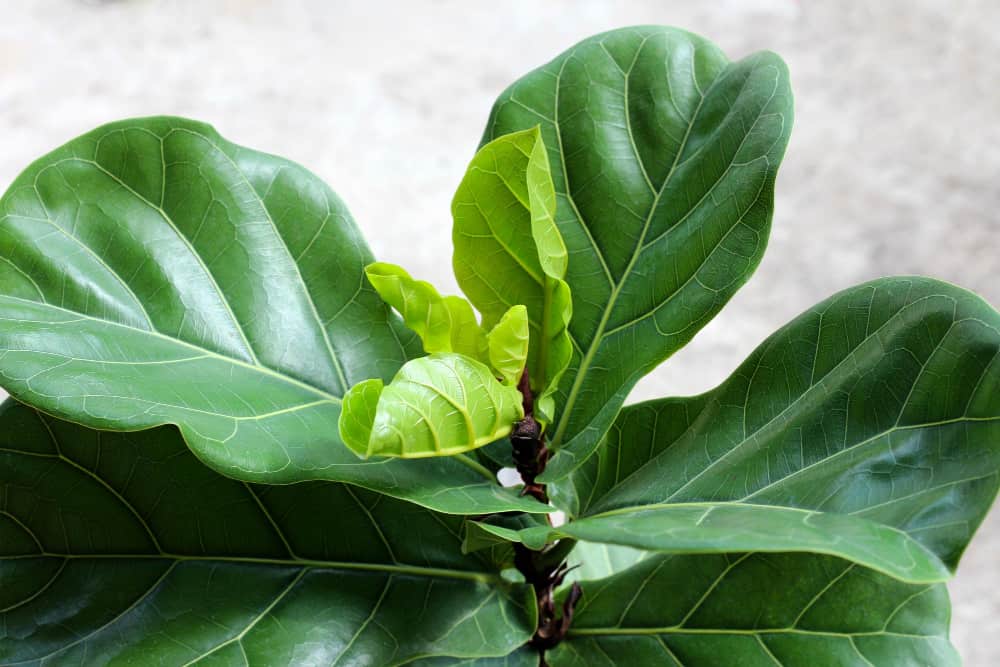
Cold Weather:-
Fiddle leaf figs are native to warm climates. So they can become stressed in cold weather. This stress is caused by the tree storing more energy as glycogen, in its trunk and roots. The tree loses leaves due to water shortages as the cold weather continues. Fiddle leaf fig drying out isn’t an uncommon problem in colder climates.
By following some simple tips, you can help your fiddle leaf fig survive these harsh conditions:
- Keep the room temperature consistent throughout the day. Keeping it at a constant 60-80° Fahrenheit will help reduce moisture loss. Water the plant less often. Regular watering can weaken fiddle leaf figs and cause the roots to rot. Between watering, allow the soil’s surface to dry out.
- If leaves are brown and withered, it may be time to repot or move the tree indoors for winter care.
- Avoid using direct sunlight inside the house during winter because it causes excessive heat gain that could lead to root cell death. Instead, use indirect light or artificial lights whenever possible.
- Mulch around plants regularly to keep the soil cool and moist – this will also prevent them from losing water through evaporation.
- To help the plant heal, remove the damaged leaves. It will be able to adapt to its new surroundings and develop healthier roots.
Heating and air conditioning:-
Heating and air conditioning are other common problems in plants and trees. It can cause leaves to turn yellow, drop off, and even die. To prevent this from happening. Ensure your fig tree has adequate ventilation (opening doors and windows regularly). Keep the area around it cool, and water it only when necessary. You can also try covering the leaves with plastic wrap during hot weather to help them keep moisture.
Homeowners can try the following tips to reduce moisture loss:
- Open windows during the day and allow fresh air in. This will help decrease humidity levels.
- Set a humidifier in the room if necessary.
- Install dehumidifiers, which use water vapor to remove moisture from the air. -Wait until the humidity levels in the house drop before heating or air conditioning.
- Water the fig tree only when the soil is dry and the leaves are yellowing or falling off.
Light:-

Fiddle-leaf figs are tropical evergreen trees that grow well in bright light, but too much light can cause problems. Too much sunlight (or daylight) causes the plant to grow vigorously, leading to yellow leaves and/or fruit and premature blooming.
On the other hand, insufficient light might result in slow growth rates or even dead branches. You can help your fiddle leaf fig by locating it in an area with plenty of indirect sunlight during the day and artificial lighting at night.
To ensure your fig tree’s success, it’s important to maintain a balance between overall sunlight exposure and intensity. You can do this by positioning your fig tree in an area with plenty of natural light, but avoid direct sunlight during peak hours (between 10 am and 3 pm). If you notice any issues with your fiddle leaf figs as a result, please don’t hesitate to call us for help!
In case your plant is getting too much light:
- To protect your plants from sunburn, it is important to place them in an area where they aren’t hit directly by sunlight. Your fiddle leaf fig will flourish if it receives 6 to 8 hours of each day of indirect sunshine. Make sure it gets at least half an hour of direct sunlight daily for optimal growth and color.
- Additionally, you may need to prune the leaves scorched by the sun. If you’re looking to keep a plant healthy, it’s important to provide it with even light throughout the day. In addition to avoiding scorching or photosynthesis issues, this will guarantee that the plant is receiving adequate sunlight and nutrients. To do this, put the plant close to a window that receives consistent light throughout the day.
- If your plant is outdoors: damaged due to too much light exposure, you will want to bring it indoors or set it under shade.
- Ensure your plant isn’t directly exposed to sunlight if positioned next to a window. You can use curtains or a screen as a filter between the light and your plants.
In case of less light:
- To increase your plant’s new growth, ensure that it is getting plenty of light on all sides.
- Find a location in your home that receives indirect light.
- If your home lacks natural light, you can use artificial light.
Fertilization:-
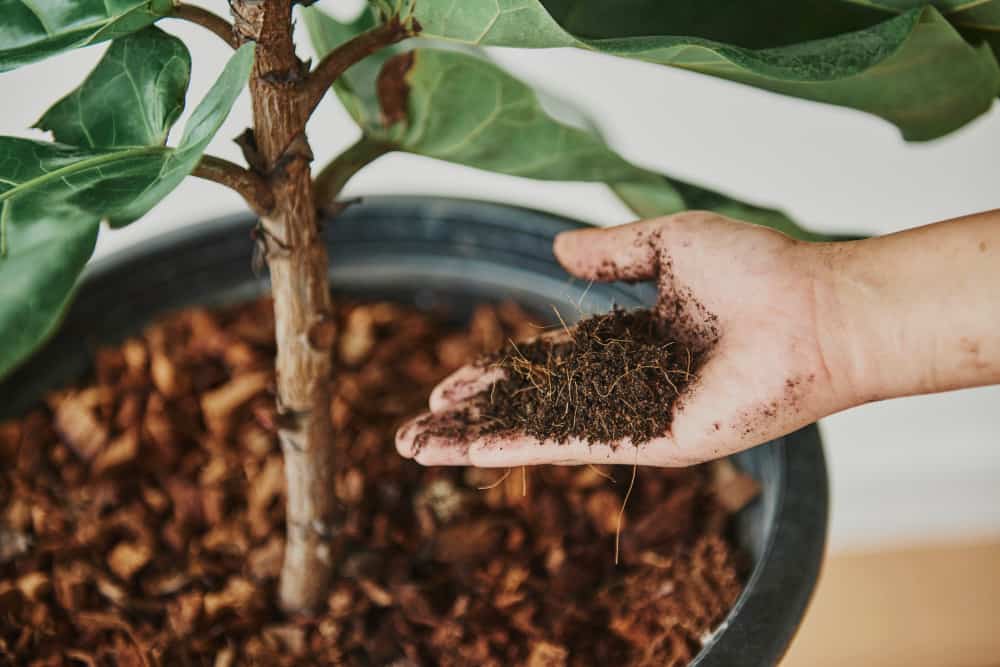
If the leaves on your fiddle leaf fig are wilting or yellowing, it may be time for a fertilizer change. Fiddle leaf figs tend to get all the nutrients they need from the soil. When it’s indoors, this is not always possible due to limitations on root reach.
For this reason, supplemental fertilization is often necessary for optimal growth and fruiting. Fertilizers should be high in nitrogen and phosphorus.
Under-fertilization can cause your fiddle leaf fig to become weak and unhealthy. This is because insufficient nutrients will not be able to support the growth of roots and leaves, leading to a decline in overall health. Additionally, under-fertilized plants are less likely to resist diseases and pests.
Over-fertilization can also have negative consequences for your fiddle leaf fig. Overheated soil becomes waterlogged, which inhibits plant growth and contributes to disease problems. Excess nitrogen levels can also create toxic conditions that harm both plants and animals that consume them.
To avoid these problems, it is important to monitor the amount of fertilizer you use on your fiddle leaf figs and ensure that the fertilizers you use are specifically designed for indoor plants (rather than general garden use). By following these tips, you should be able to provide your plants with the necessary nutrients they need without causing any damage!
Under-watered fiddle leaf fig:–
Fiddle leaf figs need frequent care to bloom. If you don’t water them, their growth rate will be slow, and their foliage will become dry and brittle. In addition, if the plant is under-watered for long periods, it may experience problems such as nutrient deficiency or diseases.
Keep these tips in mind when caring for your fiddle leaf fig:
- Never underwater your fiddle leaf fig – this will lead to dehydration and weakening the plant’s roots.
- Water plants regularly – even during hot weather – lest they suffer from moisture deficiencies. Give them at least two cups per week per plant (less in areas with less rainfall).
- Avoid water deprivation by giving long gaps between waterings; this allows trees more time to catch up on lost nutrients before experiencing any adverse effects.
Root Rot:-
A fungal infection called root rot is common on fiddle leaf figs planted in moist climates. Suppose you notice yellowing or browning of the roots. This can be caused by over-watering or under-watering in general, as well as inadequate drainage due to heavy rainfall or root rot. It’s also common due to the wrong kind of fertilizer, improper pruning, or water-soaked soil that can’t hold water. These conditions allow fungal spores to grow and reproduce rapidly, leading to the destruction of roots. If you don’t act first, your plant may die.
Thankfully, root rot is easy to prevent and treat. Here are a few tips:
- Make sure the plants are kept well-watered but not overwatered. Roots can rot when they are wet.
- Use moist but not soggy soil. Root Rot can also be caused by soil that is too wet. Roots need oxygen and water to survive, therefore make sure the soil doesn’t get soggy or damp.
- Like people, plants need a lot of light and ventilation to grow healthy. Too much darkness or heat will stunt plant growth and cause them to become stunted and weak. Overdependence on artificial lights can lead to problems like root rot.
- Fertilize only when necessary; overfertilization can also contribute to root Rot.
- Try using organic compost rather than chemical fertilizers. Such as neem oil
Insect Invasion:-
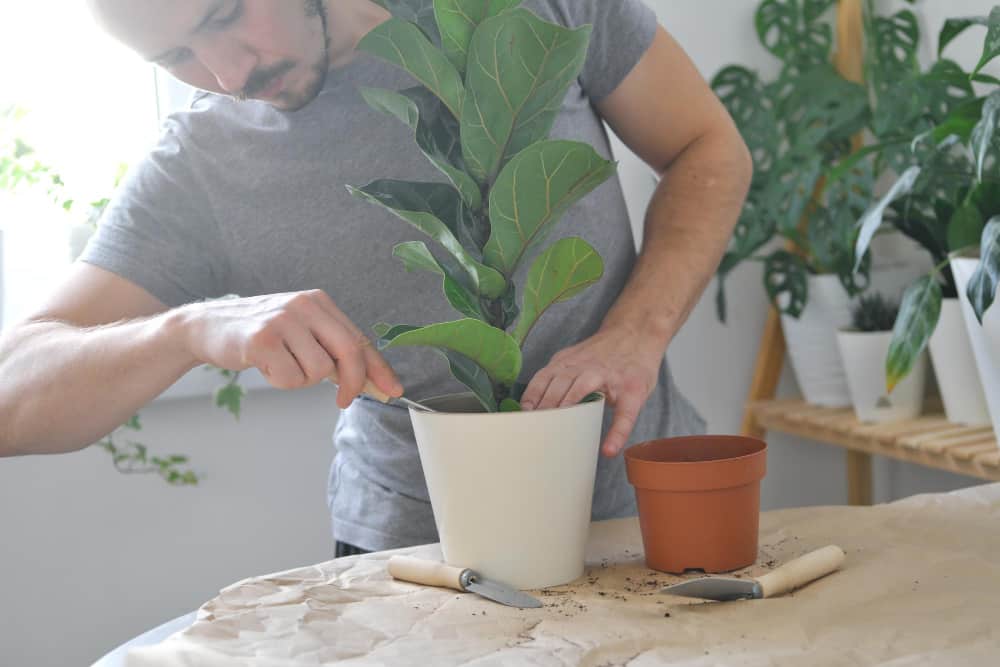
It may be difficult to detect which pest is causing the issue since so many can assault plants. However, some common signs are Slow growth, Brown and Dull leave plants are in trouble, and you should treat them immediately.
If the plant looks unhealthy or growth has slowed significantly, you should check for pests. Pests suck all of the plant’s nutrients, making it weak and susceptible to death. So, it’s important to get rid of any pests as soon as possible and restore balance to your plants’ systems.
Here are some tips on how to identify pests:
- Look for insects or insect eggs on the leaves or stems. These bugs will damage the plant severely over time.
- Check for gnats or aphids invading flowers or fruits; they will cause distorted growths and stunted fruit production.
- Check for mites feeding off roots; these small creatures feed on sap, which can cause the yellowing of foliage and weakening of plants over time.
If you are experiencing a pest infestation on your fiddle leaf fig, please follow the instructions below:
- Remove any damaged leaves and stems.
- To get rid of pests, clean the leaves with cotton dipped in soapy water.
- Neem oil can be sprayed all over the fiddle leaf fig, it keeps away pests and is organic as well.
- Spray the plant with Water
Fiddle leaf figs are resilient plants that can handle a lot, but regular care is essential to their long-term health. Please keep them in bright and filtered light every day, water when it feels cold and almost dry, and repot them every two to three years. This will help ensure that your fiddle leaf fig remains healthy and beautiful!
Maintenance tips for fiddle leaf fig

Fiddle leaf figs are lovely additions to any home, but they require a lot of care. You’ll be on your way to successfully grow your fiddle leaf fig trees if you follow these simple maintenance tips! Fiddle leaf figs need the same water, fertilizer, and sun as other trees in your yard. Here are some guidelines for keeping them healthy:
Water: Fiddle leaf figs require regular watering to maintain good health. If you don’t give them enough water, they’ll start to look droopy and pale. Mist the tree regularly or run a hose around it when it’s raining so the soil stays moist but not soggy.
Fertilizer: Once every six months is typically sufficient for fiddle leaf fig trees., However, If your soil is particularly dry or acidic, applying complete organic fertilizer once per month may be beneficial.
Sunlight: Fiddle leaf figs do best in full daylight. They appreciate some shade during hot summer days but should be exposed to direct sunlight most of the time.
How to Revive a Fiddle Leaf Fig That is Turning Brown?
You might try to save a browning fiddle leaf fig by doing a few things. The first step is to identify the cause of the problem, which may include improper water irrigation, over-fertilization, or light exposure.
Once you’ve identified the problem’s source, take steps to fix it. If your fiddle leaf fig is receiving poor watering due to improper drainage control or zoning issues, then fixing these issues will likely be necessary before attempting other treatments.
Over-fertilizing can also lead to foliage decline and browning up, so it’s important to target specific nutritional needs instead of using an indiscriminate fertilizer regimen.
Finally, if your fig has trouble tolerating direct sunlight due to its geographical location or age (old trees tend to lose their ability to photosynthesize), then shielding it with shading materials might be necessary until conditions improve again next season.
Can you save a fiddle leaf fig with no leaves?
It can be tough to watch a fiddle leaf fig wilt and die. But there is always hope. Biological systems continue to take place in the plant’s stem or roots, even if it has no leaf at all. If these functions can revive and sustain the fiddle leaf fig, it may start to regrow small leaves over time (although this process may take months or even years). So remember, don’t give up on your fiddle leaf fig too soon!
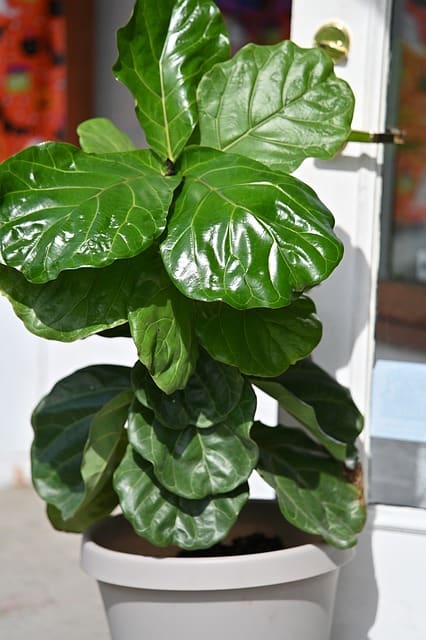
What should I do if my fiddle leaf fig begins to brown and develop dry spots?
If you notice that your fiddle leaf fig is starting to brown and develop dry spots, it’s time to take some preventative measures. You can water the plant less or spray it with a water mist once in a while. Additionally, ensure to fertilize it every two weeks with a diluted organic fertilizer and water thoroughly before planting again.
Can I transfer a fiddle leaf fig from one location to another?
Yes, you can transplant a fiddle leaf fig from one location to another it’s always better if the new location has slightly more sunlight and humidity. Additionally, ensure that the soil where you plant the fig is moist but not wet. Otherwise, water may rot it. Lastly, note the original tree’s characteristics, like height and shape so that you can find it again once transplanted.
Conclusion
Fiddle leaf fig decline is a common problem for homeowners, and it’s important to know how to revive a fiddle leaf fig to keep your tree healthy and happy. In this blog, we’ve outlined the different stages of fiddle leaf fig decline, explained the maintenance tips needed for fiddle leaf figs, and given tips on reviving a fiddle leaf fig that is turning brown. So don’t wait any longer; start reviving your fiddle leaf fig today!



